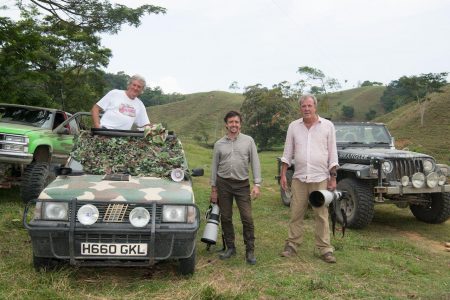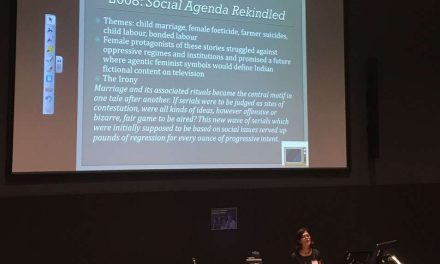As you all know, public broadcasting’s most important task for capitalism is developing genres and audiences, then delivering them to a less-creative private sector for the purposes of profit. Think football, cricket, and basketball. And think also of Amazon studios’ Grand Tour series, a simulacrum of the BBC program Top Gear.
The “Grand Tour” that gave its name to the Amazon show was a rite of passage for affluent white Europeans between the 17th and 19th centuries—an aristocratic education undertaken through travel and exposure to the arts of the other. Britain was the classic point of departure, Italy the classic destination.
Amazon’s 2019 Grand Tour series saw its three Anglo petrol-head hosts driving around Colombia, with the alibi that they were filming animals. Interviewed prior to release of this really rather excellent adventure, the trio said ‘we have to try and get from one side of the country to another, without being eaten,’ adding ‘we went on this sub-challenge, which was to become the first programme in history to go to Colombia and not use the word cocaine.’ At the season’s launch, they announced: ‘We did a whole half-hour show and talked non-stop and didn’t once mention cocaine. … The Colombians were thrilled.’ There are constant oblique references to the drug.
In fact, the two-part, two-hour special overflows with unfortunate remarks, for instance that ‘Colombia is nature’s treasure chest,’ laden with ‘lazy rivers’ and other attractions ‘far from the stain of humanity.’ This calls up an earlier history of European arrival: some conquistadores believed they had found the original Garden of Eden, watered by the Magdalena river. 18th– and 19th-century indigenous and African slave rowers shouted, prayed, and stomped to mark out their labor and connect with one another, annoying and obsessing their luxuriating white passengers in equal measure.
Since that time, the rivers that Amazon’s Anglos find so beguiling have been subject to erosion, pollution, climate change, and volcanism, courtesy of capitalist development. Wildlife has been particularly affected, with a unique turtle threatened, fishes suffering high concentrations of mercury due to goldmining, and coral reefs and sea-grass beds imperiled.
No doubt having researched that history and science with due care and respect, the first Grand Tour episode starts with the hosts driving three cars on a Cartagena de Indias beach, sans acknowledgement of the environmental impact on ‘nature’s treasure chest.’ One of the vehicles floats onto the sand from the water, wrapped up in tight polythene as if it were a giant package of cocaine.
Viewers are told that ships of the kind that had dropped this car off near the beach frequently leave Colombia for the US with ‘something’ and return empty. ‘What are they shipping?,’ asks one presenter, all faux innocence as if concealing some naughtiness or other from the beak. The next question? ‘What does Colombia produce?’ This is the first of many knowing references to cocaine, designed to elicit sniggers from the Lower Fourth. How very droll. I think I went through this in a not-very-nice 1974.
While still on the beach, they drive cavalierly into cabanas, which is presented as humorous. Once in the walled city, the chaps pilot a truck through the narrow vehicular entryway, damaging centuries-old brickwork, interrupting emergency services, and running into a fruit-seller’s cart with a jeep. Hurtling past a marina, they wonder how the nation’s agricultural industries could have made so many so wealthy. Again, the implication is cocaine—the non dit of the twin episodes.
During the drive out of Cartagena, the Grand Tour films a local man having sex with a donkey in a field, then requests an unnamed female translator to ask similarly anonymous Afro-Colombian men nearby whether this is common. One of the Anglos then asks ‘Why don’t these Colombians just grow something? Surely, there must be something … that could be sold around the world … rather than interfering with animals.’ The program’s hosts promoted this story via a column in Rupert Murdoch’s Sunday Times entitled “Cheat, Love Bray—Let Me Put My Ass on the Line and Tell You That the Donkey Sex Scene Was Real.” What a wizard wheeze!
Whether this and their other experiences were staged by Amazon’s two-dozen film crew, security guards, and local fixers matters not. What does matter is the sense of the other as providing a playground in which straight white masculinity can cavort, pretending to mock its own reference group through banter while using unidentified, mostly speechless locals as foils for a sense of humor that is as outmoded as it is unfunny. The program has drawn opprobrium from Anglo critics and activists for anti-LGBTQI “banter” between its protagonists. The donkey coverage and its paratext capture both the arrogance of public figures towards the region and the way Colombia is portrayed in dominant discourse, as a place of violence, drugs, and sex.
And I almost forgot, old thing: Cartagena, a principal site of this ripping road trip, is a World Heritage locale renowned for its colonial architecture, international colloquia, social inequality, and beach culture. It is the country’s principal tourism destination and a site for the chronic sexual exploitation of children.
The city is also a key national figure in Colombian history, symbolism, and diplomacy. Founded in 1533 by the Spanish on the site of an indigenous settlement that dated back thousands of years, it quickly became an entrepôt for silver from Perú to Spain and slaves from Africa to the colonies. Perhaps half a million people were trafficked between 1580 and 1640, seized for their skill in mining gold and as substitutes for a decimated indigenous population.
Cartagena is called La Heroica [the Heroic One] because it withstood brutal imperial blockades during colonialism and independence. Gabriel García Márquez’s El amor en los tiempos del cólera [Love in the Time of Cholera] describes the city as ‘the most beautiful in the world,’ with ‘three centuries of resistance to the sieges of the English and the atrocities of the buccaneers.’
Sir Francis Drake’s forces blockaded Cartagena in search of wealth stolen from the continent that was en route to Spain. Cartageneros call his “privateering” piracy. Their next valiant rebuff to London’s imperialism occurred in the 1740s, when thousands of UK sailors sought to starve the locals into submission as part of the Mother of Parliament’s plan to take over the entire regional slave trade. The Cartageneros’ suffering and resistance is marked in the country’s national anthem (‘la abnegación es mucha’ [heavy is the hardship]).
Things are clearly so much better now in the way white Englishmen treat Colombia. Tally ho, what? Donkeys away! It’s Amazon time.
Toby Miller is Research Professor of the Graduate Division, University of California, Riverside; Profesor Invitado, Escuela de Comunicación Social, Universidad del Norte; and Professor in the Institute for Media and Creative Industries, Loughborough University London. He is President of the Cultural Studies Association (US).




